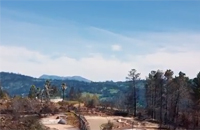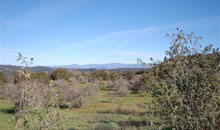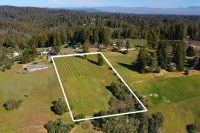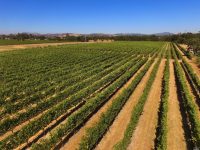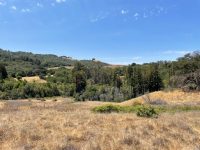Evaluating a country or a vineyard property – planted or unplanted – is a little complicated – because the properties involved are usually complicated. The goal is to understand exactly what you are buying so that we can value the property correctly and so that there are no surprises after the close of escrow. We can divide the most frequently seen set of concerns into 2 categories – those that we run into when purchasing any country property and those that are strictly related to grapes.
The general concerns relating to all country property are water, septic, county restriction and transferring title. The vineyard concerns also include water, but adds the evaluation of existing planted vineyard and/or potential vineyard land as to installation, terrain, drainage, soils, exposure (sun) and climate.
Since many of these investigations require experts and often your money, you need to be fairly far down the path towards purchase before you undertake them in any seriousness. But we do strongly recommend that you come to terms with the seller before starting any investigation that costs money. That means you’re going to have to rely on representations from the seller and assumptions based on very little real information when negotiating with the seller. This can be a very uncomfortable situation for many buyers.
It can be very disconcerting to put an offer in on a property on which it is not clear a house can be built or a vineyard installed. But that is often the case and the list of contingencies – things that need to be approved by the buyer for the transaction is completed – is usually quite long for a country property. Before you spend good money on viticulturists or septic engineers you want to know if you and the seller can come to a “meeting of the minds”. So you end up negotiating price, and crop and occupancy and everything else while still not having performed many of the essential evaluations.
Septic Permit
You’d think that in 2012, we would be able to reliably deal with our own sewage – but we can’t. Sonoma County is struggling to deal with years of easily permitted septic systems that are now failing. Regulations regarding what consitutes a site suitable for a septic system have gotten much, much more restrictive in the last 10 years. About 50% of the septic systems now approved in Sonoma County are “pressurized/mound” style systems and there are many properties which have become unbuildable since they were created. How does this happen? Before the County allows a lot to be created, it must first prove that it has water and a suitable septic site. But rules about what is a suitable site have changed so much that lots that met the regulations when they were created now no longer do – and their ability to be built upon vanished. And because of that there are many lots in Sonoma County that are unbuildable.
Yes, that means the lot can’t be built on. Which makes the lot in most cases of almost no value.
So what is the problem that makes septic systems such a challenge – In most parts of Sonoma County it is groundwater. Sonoma County wants ground water levels at least 24″ below the surface in “wet” weather for even the newest “mound” systems. If the ground water is above 24 “, no currently approved style of system will work well enough for the County.
And the County is quite a stickler about this. Composting toilets don’t cut it. There is no approved gray water treatment system either. And although there have been great advancements in residential sewage treatment systems – they are not allowed.
Determining if a property has a site suitable for a septic system can take a long time, up to a year if the site requires wet weather testings. In cases in which the County is concerned about the level of the water table at a proposed site, the County will require tests to be performed in spring under specific conditions called “wet weather testing”. So, if you buy in April, you may have to wait to next March to complete testing. So, what do you do in that situation? You usually listen to the good judgment of a respected local sanitarian or engineer or find another property.
Water – for all country properties
The County will not issue buildling permit without an on site water source. They are very strict about this – trucking in water will not work. A property without a viable water source – either well or spring – is virtually worthless. 10 gallons per minute (gpm) is a reasonable rate for a residential water well. It will easily supply the house and landscaping requirements. Many people live just fine with smaller wells by using stroage tanks. But below 5 gpm is a pretty small well that justifies close examination. In some cases a well is just old and a new, deeper well will produce just fine. In other water scarce areas, the aquifer is failing and a new well may not help. In special cases the county will allow properties to share wells.
County restrictions
Before you buy any piece of rural property you should sit down at the local buiding department and talk to the person that can explain to you the zoning and other restrictions the County imposes on the property. In addition to the basic restrictions on number of units and restrictions on use that zoning places on the property, there may also be specific restrictions such as scenic or visual restrictions that restrict where buildings can be sited. We recently spent 3 hours at the County with clients just discovering the basics of a property they were interested in.
Developed vineyard land
If you are looking at existing vineyard, you are roughly concerned with exactly the same things as if you are looking at undeveloped land, but you go about it a little differently.
First and foremost, you are concerned with the history of the vineyard. What has its production been? What have the grapes sold for? Who are the contracts with? Based on this you should be able to get an idea of the vineyard as an ongoing business. All this information should be available from the listing agent. Second, you need to look at the vineyard for any problems with the infrastructure. Is any of the vineyard on AXR rootstock? If yes, the value per acre of the vineayrd with AXR is discounted. Is there enough water to irrigate and provide frost protection if needed? If not, is there another source avaible – can another well be drilled or a pond built? What condition is the trellis system? Are there drainage and/or erosion problems that need to be addressed? All of these can be looked at by a reputable vineyard manager.
Third you need to look at the vines and the soil. For this you’ll need a viticulturalist. Hopefully you can do this during the growing season when leaves can be taken and sent to the lab and soil samples can be sent to the lab as well. From these you can identify other current and/or potential problems with the vineyard.
Plantable but unplanted and undeveloped vineyard land.
Hopefuly the sellers have engaged the appropriate professionals to conduct all the necessary analysis and have reports available to you, the buyer. However, often that’s not the case. I’ll take the worst case situation and walk through the steps. You can remove steps that don’t apply to any particular situation.
1. Indentify a property – It usually takes 4 or 5 visits before finally narrowing in on a property.
2. Perform a rough analysis of the number of plantable acres based on available information. This step allows you to develop a basic value for the property. It may require walking the parcel with a GPS unit to approximate plantable acres. Or it may require a short on-site visit with a viticulturalist to assess basic vineyard potential.
3. Make an offer and negotiate to acceptance. The rest of the process is time consuming and costly and there is little point in engaging in it if in the end you can’t agree on a price. The offer would be contingent on the inspections and reports being to your satisfaction. If you are not happy with either the soils report or the number of plantable acres or the water quality you can terminate the contract at any time.You might also ask the seller to pay for this work if the deal falls through and that you only pay if you complete the purchase – but that’s very negotiable.
4. We now start on a series of inspections aimed at producing the following:
- Septic permit
- Sufficient water of suitable quality
- The actual number of plantable acres
- Soil of suitable stability and chemistry
- Rough understanding of the vineyard design and cost.
- Basic understanding of local climate including threat of frost.
Water – just for vineyards
If there is a well, then the well needs to be tested for Boron and levels of salt. Boron is toxic over 1 ppm. And some salts can interract with some fertilizers. It’s not a problem, you just need to be aware to avoid making concrete (literally) in your drip irrigation system. You also have to test the well for its current level of production. Don’t trust anyone’s representations of well production – even mine. Every well has a log and the log shows the number of gallons a minute the well produced when it was new. But that can change over time. The best thing to do is to hire a pump company to run the pump in the well for 12 to 24 hours with a flow meter on it to determine its current production level. Sometimes, the well log indicates more water than the current pump is capable of delivering. If you need that additional water, and you usually do for a vineyard, then the pump company may also have to remove the existing pump and install a “test pump” for the 12 or 24 hour test.
Based on the rough assessment of the property and new information coming in from other experts, you should have a good idea of how many acres are plantable. You should also have some idea how much, if any, of the vineyard is subject to frost.. From the total acreage and the acreage subject to frost, you should be able to determine, after consultation with a couple more experts, how many gallons per minute of water you will need for the vineyard. See the article on Vineyard Infrastructure for the basics on making the computation. Don’t worry about how much water the house needs if you are close. The house can easily operate off a tank that is filled in the middle of the night.
If the existing well does not have enough water, then the options are more well(s) – which is what we did here – or ponds. The choice depends on the parcel. Many have ponds and many don’t have enough water under them for wells to work. Either way, the cost and risk of getting the required water needs to be determined.
Plantable Acres
There are 4 or 5 major criteria that go into determine how many acres are plantable.
An accurately determined outline of the area
Slope – Above 30% is usually financially impratical
Soil – Extremely high magnesium soils are out
Stability – Landslides are common around Sonoma County.
Expense – Rock removal and drainage requirements are the two culprits that can make a property or a section of property unplantable.
And it takes a few experts to generate all this information. Please see The Team to see the experts that I often work with.
- Surveyor
- Soil engineer
- Viticulturalist
- Civil engineer specializing in vineyard development
- Vineyard manager
Fortunately, many of the tests require the same thing -lots of holes in the ground. Although the boundaries and slope can be determined above ground by a surveyor – often using an arial photograph – the rest requires a series of test pits dug with a backhoe usually averaging about 1 to the acre of plantable land and focusing on each unique topographic feature or area of unique soil.
Into these holes will jump the soil engineer to evaluate stability, the viticulturalist to take samples for the lab and look at soil texture and tilth, the civil engineer to look at drainage capacity and the vineyard manager to assess the amount of rock and/or wet spots to be dealt. The civil engineer and the vineyard manager will also look at the overall site for riparian corridors, wetlands, or other features that will require special attention or can’t be planted.
Suitable SoilsWhile in the pit, the viticulturalist will take soil samples and look at soil composition and texture. From the results of the lab analysis done on the samples and on his or her notes taken in the field. He or she will produce a report indicating the suitability of the soil for grapes and any amendments required prior to planting or special conditions – like high magnesium.
Climate
The final and most difficult element to nail down is the local climate. If you are lucky, there is neighbor with detailed weather data for the last 10 years. If not, you are going to have to talk to neighbors about their vineyards and gardens. What you want to know is: Are there frost between March 1 and May 10? How hot is it? How windy is it? From these three questions, you should be able determine you climate relative to other climates in the County.
Your viticulturalist will be able to help you identify grape varieties that will work with you soils and climate

